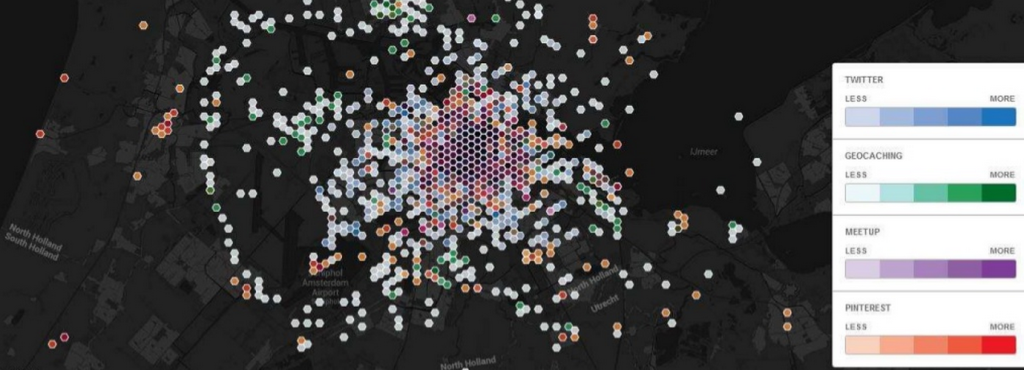The City as Interface : how social networking services remediate the city
Where in the city do people hang out? What groups do they form? What do they talk about? Today, as we spend most or our time ‘online’ (and when in public space only half present) finding an answer to those questions involves the study of social networking services.
Naomi Bueno de Mesquita participated in a two week summer school of Digital Methods Initiative in July 2014. DMI is a collaboration initiated in 2007 between the New Media TEMLab, University of Amsterdam and the Govcom.org Foundation Amsterdam and aims at reworking methods for Internet research. DMI seeks to learn from the methods built into devices online, by subtracting the data (links, tags, threads, etc) and repurposing them for social and cultural research. The theme for this summer school was ‘on geolocation’ and the focal point was to analyse events as they unfold, by subtracting geo-located embedded data. Naomi participated in the group project The City as Interface (lead by Martijn de Waal). In this research she investigated the kind of Amsterdam that the social networking services Foursquare, Twitter, Pinterest, Flickr, Meetup and Geocaching, present and if different parochial (communities) and public domains (individuals) could be identified by looking at the places that are put forward by these platforms.
The data for this study was produced and published by Amsterdam based users, and subtracted from the networking services Twitter, Meetup, Pinterest and Geocaching. Through applying digital methods, the geo-located embedded links, tags, threads and pin-boards were mapped, demonstrating the places in the city where the different virtual communities talk about or ‘hang out’. For the Twitter dataset the keyword ‘Amsterdam’ was retrieved over a ten-day period (June 13th-22nd 2014). As for the datasets of Pinterest, the term ‘Amsterdam’ was searched for in ‘place’ boards. The dataset of Meetup gave 489 events over a four-month period in this city. And for Geocaching all the existing caches (718, of which 39 temporarily inactive) placed in Amsterdam were collected. As for the localisation of the communities of these social networking services, the map reveals that Twitter, Meetup and Pinterest are located in or around the city centre; Pinterest clearly represents the boutique view of Amsterdam (outlining the nine-streets, Haarlemmerdijk and Haarlemmerstraat), while the virtually constructed communities of Meetup consist of people with a common interest (for instance in technology, fitness or fine arts) who temporarily gather in bars (with a high concentration around the square of Nieuwmarkt). Of these four (social) networking services, only the users of Geocaching are likely to engage with places that are harder to get to, e.g. the city’s periphery. Geocaching is therefore the most widely spread community (of the ones that we studied) in Amsterdam in terms of physical range.
This research was further presented in a paper (publication forthcoming) that Naomi wrote together with Saba Golchehr, for the conference Design Social Media and Technology to Foster Civic Engagement (University of Hasselt). In the paper they introduce the study of social media data as a valuable resource for designers and researchers who work in (the context of) public space.
I’d be interested to find out if there are other examples of designers that make use of social networking services to recognise local communities and what the further potentials and limitations are of this approach.




Discussion The City as Interface : how social networking services remediate the city